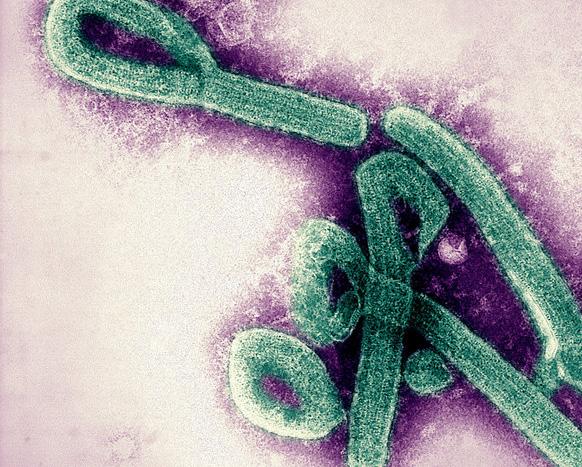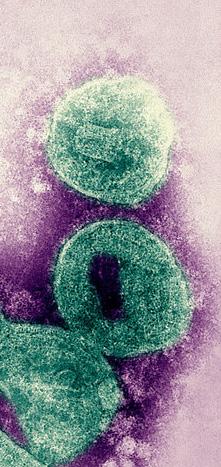
3 minute read
Profile of a pathogen
Marburg virus
This is one of those viruses that keep people awake at night. The Marburg virus (MARV) causes Marburg haemorrhagic fever (Marburg HF). Haemorrhagic fevers cause the patient to bleed profusely from the body’s orifices and Marburg HF is an extremely severe form. Though the first known crossing of the virus from animal to human was via monkeys, the host of this particular virus is the African fruit bat, Rousettus aegyptiacus, which show no obvious signs of illness when infected.
Marburg HF is a filovirus belonging to a group of viruses called Filoviridae, which cause severe haemorrhagic fever. It is fatal in both humans and nonhuman primates. So far, three genera of this virus family have been identified: Ebola virus, Cueva virus and Marburg virus. It was first encountered in Germany and
Haemorrhagic fever A general term for a severe illness, often associated with bleeding, that can be caused by a number of viruses. Barrier nursing A set of stringent infection control techniques used to protect medical staff against infection by patients. Blood clotting factors A group of proteins found in the blood that are essential to blood clot formation.

part of Yugoslavia, which is now Serbia, in August 1967. Thirty-one people were admitted to hospitals in Marburg, Frankfurt and Belgrade, suffering fever symptoms. The first patients were laboratory assistants who had been handling African green monkeys imported from Uganda but were soon followed by some of the medical personnel and family members who had cared for them.
The hospitals soon determined that they had a type of haemorrhagic fever, but every test for pathogens known to cause the disease returned negative. Clinicians realised they were dealing with an unknown virus and after seven of the 31 died, the investigation was moved to more specialised laboratories. One of two Marburg viruses, A and B, that cause illness in humans, was isolated in November the same year.
The incubation period is between five to 10 days, with the first symptoms being a high fever, chills, headache and muscle pain. At around the fifth day, when most people would expect to start feeling better, another raft of symptoms begin to arrive. These include a maculopapular rash, which looks like red bumps on a flat red patch of skin, nausea, vomiting, abdominal pain, chest pain, a sore throat, and often diarrhoea. The symptoms become increasingly severe and can include jaundice, inflammation of the pancreas, severe weight loss, delirium, shock, liver failure, multi-organ dysfunction and the massive bleeding from various parts of the body that gives this kind of fever its name.
The main mode of transmission is through person-to-person contact, which can happen in several ways: direct contact to droplets of body fluids from infected people or through contact with equipment and other objects contaminated with infectious blood or tissues. Historically, the people at highest risk include family members and hospital staff who care for patients infected with Marburg virus, often without the proper barrier nursing techniques available to them. Particular occupations such as veterinarians and laboratory or quarantine facility workers who handle non-human primates from Africa may also be at increased risk of exposure to MARV.
The nature of the disease means that the mortality rate is very dependent on where you are when contracting the disease. Modern medicine is very good at keeping very sick people alive and eventually returning them to health. Even so, with the best care delivered in a timely fashion, the mortality of Marburg HF is 30%, which is high. However, in cases of poor care—or none at all— mortality rises to 90%.
The problem is that there is no specific treatment for Marburg haemorrhagic fever. All clinicians can do is support the body through the worst of the disease through processes like balancing the patient’s fluids and electrolytes, maintaining oxygen levels, keeping blood pressure stable, replacing lost blood and blood clotting factors, and treating any complicating infections. Experimental treatments are showing some promise in non-human primate models, but as yet none have been tried in humans. Marburg haemorrhagic fever remains, for the foreseeable future, an extremely distressing and dangerous disease.

PP42
ww
A healthy heart
Julian Best of The Howard de Walden Estate and Dr Brian Donley of Cleveland Clinic discuss how the Harley Street Medical Area has become a global healthcare hub of sufficient reputation to draw one of the USA’s most influential clinics into its ranks







